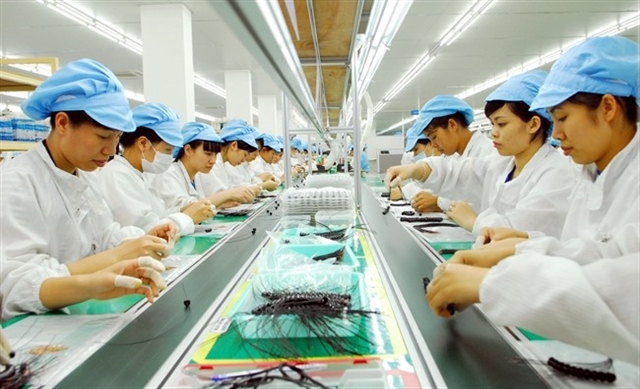Electronics exporters aim to hit $145 billion target by the end of 2025
Việt Nam’s electronics industry is well positioned for growth, given its location in a rapidly developing and dynamic industrial region.
HÀ NỘI — Việt Nam is aiming for a milestone of reaching US$145 billion in electronics exports for this year.
Amid ongoing changes in global geopolitics and rapid development of technology, the country is gradually transforming from a manufacturing centre to a high-tech innovation hub in the region.
Electronics exports boomed last year, earning nearly $126.5 billion in revenue, an increase of $17 billion compared to 2023.
Computers, electronics and components were the largest export category in the first eight months of the year, reaching $56.7 billion. This group of products accounted for the highest share of Việt Nam's total export turnover.
The domestic electronics industry is well positioned for growth, given its location in a rapidly developing and dynamic industrial region. The country also benefits from a domestic market of over 100 million people and direct access to the ASEAN market of 600 million people.
Việt Nam's international export market is vast, with the country participating in free trade agreements (FTAs) with many nations around the world.
Trần Đức Hoà, deputy sales director at Vietnam Post and Telecommunication Industry Technology JSC (VNPT Technology), stated that companies were expected to continue investing in automation robots, as many businesses look to shift production to Việt Nam.
The future growth potential for the electronics technology sector is significant, despite global economic, trade and geopolitical disruptions affecting supply chains and logistics.
Investment in the sector continues, as evidenced by ongoing and upcoming projects. For example, Foxconn’s $500 million investment project is scheduled to begin production by May 2027, and Pegatron Group (Taiwan) is set to invest $500 million in its third factory in Hải Phòng by the end of next year.
These projects will further solidify Việt Nam's position as a key player in the global technology supply chain and provide a strong boost to the country’s export growth.
However, behind these impressive figures lie several challenges. Currently, 100 per cent of the value of mobile phone exports comes from foreign direct investment (FDI), but 80 per cent of the components still need to be imported.
Over 90 per cent of Tier 1 suppliers are FDI firms, and the domestic capacity for research and development remains limited, with Vietnamese companies primarily engaged in assembly.
These challenges highlight the need for Việt Nam’s electronics industry to transition from an assembly hub to a deep manufacturing nation. This shift requires dynamic, creative cooperation between businesses and educational institutions.
The VOV online newspaper quoted Nguyễn Đức Minh, vice-rector of the School of Electrical Engineering and Electronics, as saying that most small- and medium-sized enterprises (SMEs) lack the capital to invest in automated production lines.
However, Vietnamese businesses do have the advantage of being quick to update knowledge and apply new technologies, he added.
Electronics are among the country's key export sectors, accounting for over 30 per cent of the country's total export value last year. The US was the largest export market for Việt Nam in 2024, with a share of over 40 per cent in some sub-sectors. China, on the other hand, is the largest supplier of raw materials, accounting for 80 per cent of components and materials used in Việt Nam's electronics industry.
Current global uncertainties present an opportunity for Việt Nam to restructure its supply chains, accelerate digital transformation and expand its market reach through FTAs and cross-border e-commerce to enhance exports, said analysts.
Đỗ Thị Thúy Hương, executive committee member of the Vietnam Electronic Industries Association and Vice President of the Vietnam Association for Supporting Industries, suggested that businesses should diversify their export markets and take advantage of 17 FTAs with nearly 70 economies to gain a competitive edge.
"In addition to the significant advantages for electronics products to the EU, Japan, Korea and China, businesses should also explore niche markets such as Northern Europe, South America, the Middle East and Africa.
"Therefore, companies should study potential markets, such as India, which has the largest population in the world, and develop long-term strategies to invest in research and brand building in new markets," said Hương.
Source: VNS
Photo: VNA/VNS





